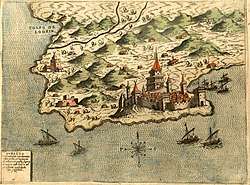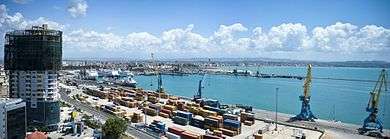Port of Durrës
The Port of Durrës (Albanian: Porti i Durrësit) is the largest seaport of Albania. The port is situated in the city of Durrës. It is an artificial basin that is formed between two moles, with a west-northwesterly oriented entrance approximately 183 metres (600 ft) wide as it passes between the ends of the moles. The Port is located at the north end of the Bay of Durrës, an extensive body of water between Kalaja e Turrës and Cape Durrës. Cape Durrës is located approximately 1.6 kilometres (0.99 mi) west of the Port of Durrës.[5]
| Port of Durrës | |
|---|---|
 | |
| Location | |
| Country | Albania |
| Location | Durrës, Albania |
| Coordinates | 41°18′35″N 19°27′26″E |
| UN/LOCODE | ALDRZ[1] |
| Details | |
| Opened | Since Illyrians7th century BC |
| Operated by | Durrës Port Authority |
| Owned by | Government of Albania |
| Type of harbor | Artificial |
| Size of harbor | 67 hectares |
| Land area | 80 hectares |
| Available berths | 2275 ml |
| Employees | 623 (2009) [2] |
| Cargo company | Cargotec [3] |
| UNCTAD | ALDRZ |
| Depth | 5,6-11.2 m |
| Statistics | |
| Annual cargo tonnage | |
| Annual container volume | |
| Passenger traffic | |
| Website www | |
As of 2014, the port ranks as the largest passenger port in Albania and one of the largest passenger port in the Adriatic Sea, with annual passenger volume of approximately 1.5 million. The Port of Durrës has approximately 763 metres (2,503 ft) of alongside pier space on the West Mole and a fishing harbor lies at the north end of the East Mole.[6] Several wrecks are located near the entrance channel to the Port of Durrës. The use of tugboats is compulsory in the Port of Durrës.[7] As of 2011, the port is undergoing major renovation and expansion.
History

Epidamnos (Durrës) was seized by Glaukias, the king of Illyria, in 312 BC, but after a war with the Roman Republic in 229 BC ended in a decisive defeat for the Illyrians the city passed to Roman rule, under which it was developed as a major military and naval base. The Romans renamed it Dyrrachium (Greek: Δυρράχιον/Dyrrhachion). They considered the name Epidamnos to be inauspicious because of its wholly coincidental similarities with the Latin word damnum, meaning "loss" or "harm". The meaning of Dyrrachium ("bad spine" or "difficult ridge" in Greek) is unclear but it has been suggested that it refers to the imposing cliffs near the city. Julius Caesar's rival Pompey made a stand there in 48 BC before fleeing south to Greece. Under Roman rule, Dyrrachium prospered; it became the western end of the Via Egnatia, the great Roman road that led to Thessalonica and on to Constantinople. Another lesser road led south to the city of Buthrotum, the modern Butrint. The Roman emperor Caesar Augustus made the city a colony for veterans of his legions following the Battle of Actium, proclaiming it a civitas libera (free town).
In the 4th century AD, Dyrrachium was made the capital of the Roman province of Epirus nova. It was the birthplace of the emperor Anastasius I in circa 430. Some time later that century, Dyrrachium was struck by a powerful earthquake which destroyed the city's defences. Anastasius I rebuilt and strengthened the city walls, thus creating the strongest fortifications in the western Balkans.

The 12 m (36 ft)-high walls were so thick that, according to the Byzantine historian Anna Komnene, four horsemen could ride abreast on them. Significant portions of the ancient city defences still remain, although they have been much reduced over the centuries.
Like much of the rest of the Balkans, Dyrrachium and the surrounding Dyrraciensis provinciae suffered considerably from barbarian incursions during the Migrations Period. It was besieged in 481 by Theodoric the Great, king of the Ostrogoths, and in subsequent centuries had to fend off frequent attacks by the Bulgarians. Unaffected by the fall of the Western Roman Empire, the city continued under the Byzantine Empire as an important port and a major link between the Empire and western Europe. During communism in Albania, the port was named after Albanian communist leader, Enver Hoxha.
References
- "UNLOCODE (AL) - ALBANIA". service.unece.org. UNECE. Retrieved 17 April 2020.
- "Archived copy" (PDF). Archived from the original (PDF) on 2012-03-16. Retrieved 2011-03-19.CS1 maint: archived copy as title (link)
- "Port of Durrës". My new desk.
- "Albania's Durres port opens new passenger terminal". Setimes.
- "Additional info". nrlmry navy.
- "Additional info". nrlmry navy.
- "Port of Durrës". Seaport Homestead.